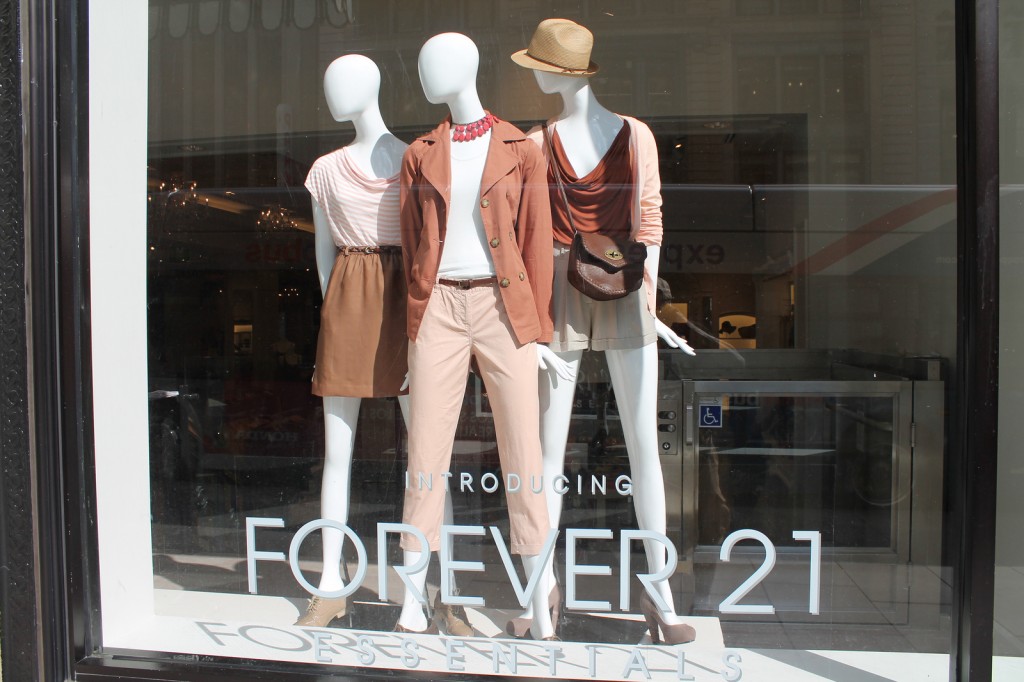Print Edition: November 20, 2013

If you’re a university student, you’re probably wearing a piece of it right now. It’s called “fast fashion.”
It works like this: whenever a hot new style is sent down the runway for the upcoming fashion season, cheap clothing companies like H&M, Zara, and Forever 21 leap into action to recreate it as quickly and inexpensively as possible. Is a trendy, high-waisted leather skirt that retails for $600 at Neiman Marcus out of your price range? Fast fashion stores will sell you a lookalike—a knockoff, as suffering high-fashion designers bitterly call it—for 20 bucks. This way, we can dress like our favorite ultra-chic celebrities at a price that won’t implode our bank accounts.
But don’t celebrate yet, fashionistas. The result is inexpensive, trendy clothing that conforms to the latest fashions, but gets tossed in the garbage when it goes out of style in three months – if it doesn’t wear out first.
In short, fast fashion is the sartorial equivalent of fast food: cheap, poorly made, and instantly gratifying.
Unfortunately, while fast fashion is cheap to make and cheap to buy, there’s a different kind of price attached to it. There are some uncomfortable questions which we have a responsibility to consider before getting sucked in by the addictively low prices and cute clothes.
First, consider the environmental impact of a system that encourages people to throw out clothing after a single season of use. Landfills are filling up with lace-hemmed tank tops, peep-toe booties, and other dead trends from recent years, quickly worn and quickly discarded – but often made of cheap materials like polyester which won’t decompose for hundreds of years.
As well, refuse and wastewater from clothing factories often contain carcinogenic dyes, hormone-disrupting chemicals, and other dangerous pollutants that seriously harm any ecosystem that’s exposed to them.
Questions have also been raised about the rights of workers who churn out fast fashion garments, often in sweatshop-like conditions. Because big fashion companies usually outsource their labour to countries like China or India, it’s often difficult to get the whole story about how their employees are being treated.
In April this year, an eight-storey textiles manufacturing facility in Bangladesh collapsed, killing 1,129 workers who were ordered to stay inside and continue working despite concerns that the building wasn’t safe. The tragedy highlighted the exploitation of fashion industry workers in third world countries, who are often underage and almost always underpaid. If Forever 21 can afford to sell that top for $10 after mark-up, how much did it cost them to pay the worker who made it?
Also, if you love high fashion brands like Chanel, Louis Vuitton, and Alexander McQueen, you may want to think twice before supporting fast fashion. Upscale designers are haemorrhaging money as they lose business to the fast fashion industry, which replicates their styles at a price anyone can afford.
The problem is that we’ve glamourized a wasteful lifestyle where trends come and go as quickly as we can keep up with them. Instead of trying to keep up with the latest trends, slow it down. Try investing in classic styles that don’t go “out” so quickly. Spend a little more money a little less often and you’ll get something that will last – just like your grandma used to tell you.
If you absolutely can’t live without your fast fashion fix, though, the new H&M at Highstreet Mall is actually one of your best options. In the last couple of years, they’ve become known as one of the more ethical and environmentally conscious fast fashion companies. In February they started their international garment recycling program: for every bag of used clothing you bring to an H&M store, including clothing from any brand and in any condition, you’ll receive a $5 voucher to spend in the store. Your old clothes will be turned into other textile products, recycled into new material, or otherwise salvaged and saved from the landfill.
But if you really want to be a savvy, eco-conscious shopper, hit up a thrift store the next time you’re looking for a pair of jeans. You’ll be doing your planet, your wallet, your wardrobe, and your conscience all a big favour – and what’s more stylish than being smart?


